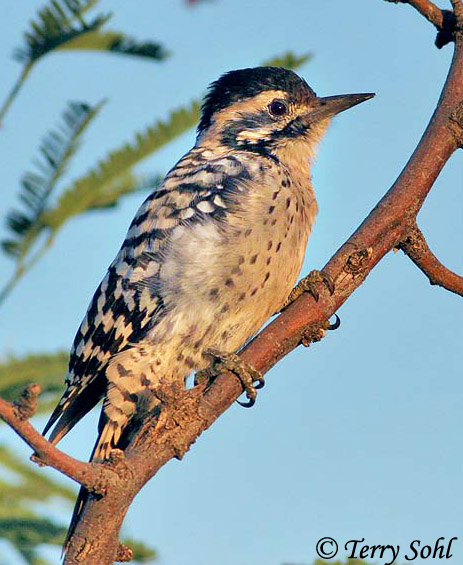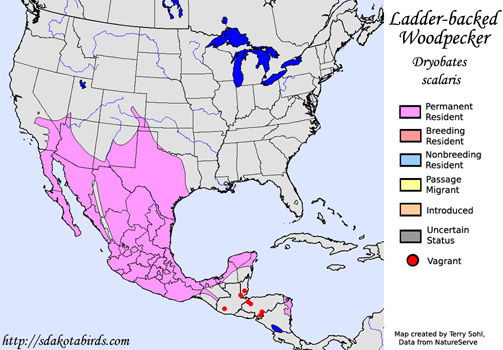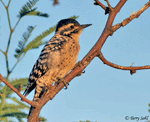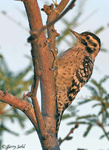Ladder-backed Woodpecker
Dryobates scalaris
| Length: 7 inches | Wingspan: 13 inches | Seasonality: Non-resident in South Dakota |
| ID Keys: Black-and-white barring on back, light underneath with spots on sides, black stripes bordering white cheek | ||
 The
Ladder-backed Woodpecker is a small woodpecker of dry habitats in the
southwestern U.S. Their range extends southward through Mexico and
into central America. While inhabiting generally similar habitat as
other larger woodpeckers of the desert southwest, Ladder-backed Woodpeckers
are able to thrive in areas without large trees, with stands of mesquite or
other small desert trees typically adequate to support nesting populations.
The
Ladder-backed Woodpecker is a small woodpecker of dry habitats in the
southwestern U.S. Their range extends southward through Mexico and
into central America. While inhabiting generally similar habitat as
other larger woodpeckers of the desert southwest, Ladder-backed Woodpeckers
are able to thrive in areas without large trees, with stands of mesquite or
other small desert trees typically adequate to support nesting populations.
Habitat: Found in mostly dry shrubby habitats in the American Southwest with scattered trees, such as in and around riparian areas, desert washes, mequite stands, and suburban trees.
Diet: Primarily feeds on insects, but will also feed on fruits and berries.
Behavior: Forages using a variety of techniques, but primarily by climbing and flitting through shrubs and small trees, gleaning insects from foliage and branches. They will also sometimes forage on the ground for insects.
Nesting: The nest of a Ladder-backed Woodpecker is in a tree cavity. They often use mesquite, oak, or other deciduous trees, but they also will use cavities in Joshua trees, saguaro cactus, or telephone poles. Both parents help to incubate the eggs, and both parents tend to the young and help feed them.
Song: Has a variety of calls, including a staccato "pik" call, and a slow rattling call.
Migration: Considered a permanent resident throughout its North American range.
Interactive eBird Map: Click here to access an interactive eBird map of Ladder-backed Woodpecker sightings
Similar Species: Nuttall's Woodpecker, Downy Woodpecker
Conservation Status: Populations of the Ladder-backed Woodpecker appear to be stable, and there's a wide geographic range for the species. The IUCN currently lists the Ladder-backed Woodpecker as a species of "Least Concern".
Further Information: 1) Cornell's All About Birds - Ladder-backed Woodpecker
2) California Partners in Flight - Ladder-backed Woodpecker Conservation Plan
3) National Geographic - Ladder-backed Woodpecker
Photo Information: Photo taken on September 13th, 2006 - Outskirts of Tucson, Arizona - Terry Sohl
| Click below for a higher-resolution map |
 |
| South Dakota Status: Non-resident in South Dakota |
Additional Ladder-backed Woodpecker Photos
Click for a higher-resolution version of these photos


